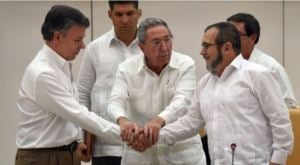170 Social Leaders Killed in Colombia in 2017: Report
Community leader killings in Cauca, Nariño and Choco are related to land conflicts, while those in Bajo Cauca are related to illegal mining.

An estimated 170 Colombian social leaders were killed in 2017, up from 117 in 2016, according to the Institute of Studies for Peace Development, Indepaz, a Colombian non-governmental organization.
“The rise in homicides is over two main conflicts: (access to) land and (natural) resources. This latter refers to the rentiership in illegal mining and cultivation of illicit crops,” said Indepaz director Camilo Gonzalez Posso.
The report indicated that the murders are highly localized to four regional departments: Nariño (28), Antioquia (23), Valle (14) and Choco (12). There were 32 assassinations alone in the community of San Jose de Apartado Cauca located in Antioquia.
Posso added that the community leader killings in Cauca, Nariño and Choco are related to land conflicts, while those in Bajo Cauca are related to illegal mining.
“The majority of the killings are committed by armed men in areas where previously the FARC (Revolutionary Armed Forces of Colombia) used to rule.”
Leonardo Gonzalez, also of Indepaz, said that as the FARC left these territories, killings have increased.
The FARC began as a Marxist guerrilla movement in 1960s that advocated for peasant access to farmland. It gained the support of peasants and activists in rural areas over the past several decades. The administration of President Juan Manuel Santos eventually reached an accord with the FARC in November 2016, which included the group’s disarmament. Since the FARC’s leaving, violent right-wing paramilitaries have taken over.
“Where the (FARC) left, other paramilitaries … have arrived to take over the territories, by force”, Gonzalez said.
Maribel Perafan, the country’s Secretary of Government, said that the government is prioritizing the investigation into the 170 deaths. She said it’s necessary to “institutionalize” the protection of the human rights and social leaders.
Yet, social rights defenders in these areas have no guarantees, contended Modesto Serna from the Choco government. He said that the FARC’s leaving has left a vacuum, which hasn’t been replaced by the state, but “criminal gangs.” “We can’t fool ourselves,” he said of those who deny this is the scenario in Colombia.
The government created the National Protection Unity, UNP, after the historic agreement was reached to protect against potential threats and killings of social rights leaders in Colombia. However, according to Edgar Insandara of the Nariño government, when leaders report threats to the UNP,
“we find that there’s no effective state response. It’s very difficult to say that people are protected.”
Meanwhile, Luis Carlos Villegas of Colombia’s Department of Defense said the killings are unrelated and “personal” and therefore, are not “systematic” to the political situation within the country. He does say though that they are “absolutely unacceptable.
The government did announce last week that in order to protect social leaders, it’s sending out 63,000 of its own military soldiers to patrol 67 municipalities and 595 hamlets of the most affected areas, under Plan Uris.
Gonzalez, a principal author of the Indepaz report, concludes,
“we’re living in a transition from a war, which lasted many years, to a moment of peace. Now is the most important time to ensure that we don’t enter a new war. We have to strengthen (our) democracy.”
Starting Jan. 9, the Santos administration will sit down with mediators and members of the National Liberation Army, or ELN, in Quito to reaffirm disarmament talks. This is a follow up to their September meeting in the Andean capital city.
This is following the president’s discussions last week with former FARC leaders to review their peace agreement advancements and challenges one year after it was signed.

